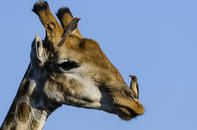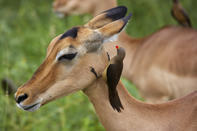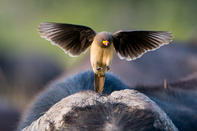Associate with Herbivores

Oxpeckers - Buphagus spp
Oxpeckers live in association with medium to large mammalian herbivores. The smallest hosts they use are impala and warthog and the largest rhino, buffalo and hippo.
These birds spend their daylight hours picking and consuming parasites out of the pelage of their hosts in a win-win relationship known as mutualistic symbiosis. Both species involved gain several advantages from their relationship.
Herbivores benefit greatly by having their coats stripped of blood-sucking invertebrates. In a kingdom where survival is awarded to the fittest individuals, blood-loss caused by parasites picked up in habitats carrying high tick loads, constitutes energy loss.
Energy-loss puts animals at a competitive disadvantage. Not only are animals weaker on a day to day basis to find food and avoid enemies but they may lose critical condition necessary for being the strongest contender to mate.
Oxpeckers do not remove all the ticks on an individual but they control the infestations to a large degree and prevent overspill of high loads into the environment from where secondary infestations could potentially occur.
Early Warning System

Oxpeckers also benefit their mammalian hosts by affording them an early warning system. Birds are generally more vigilant than mammals and oxpeckers especially, fly up noisily if they are startled, hissing and rasping characteristically. Herbivores respond to oxpeckers alarm calls.
Oxpeckers can help warn humans of potential danger or alert them to the presence of a large herbivore. Oxpeckers will fly up off the backs of their hosts if startled indicating the presence of potentially dangerous game.
They also descend onto their hosts noisily. The dipping flight of a flock of oxpeckers with the accompanying chip-chip-rasp call, is unmistakable. One can visually track the bird’s flight and witness where they descend. At that location it is most likely that there are host species including buffalo or rhino.
Alpha Breeders
Oxpeckers are co-operative breeders with only one pair in the group (usually comprising about five birds in total) that actually court and breed. Mating usually takes place on a host animal after a showy performance where the courting pair encircles one another with spread wings shivering and beaks ajar.
Only the dominant pair incubate the eggs but the other members of the flock known as ‘helpers’, help to feed the brood and remove telltale signs of the nest like egg shells and faecal sacs. Many of the helpers are offspring from previous broods. All the members of the group are related and so kinship selection ensures that the individuals’ gene-line is still perpetuated.
Oxpeckers utilize natural cavities in trees to nest and they especially favour leadwoods where old branches have split off from the main trunk and left a hole behind. Holes are located and approved of by the entire flock. Oxpeckers scout for holes during inspection flights from the backs of their hosts.
Once a suitable hole has been located, the site may be used consecutively year after year due to stiff competition from other hole-nesting species like starlings.
Tripod Tails

Oxpeckers have very sharp claws which help the birds to cling to the fur of their hosts while they forage for parasites
Oxpeckers line their nests with hair that they pluck from their mammal hosts. This is placed on top of a few blades of grass in a cup-like form which becomes flattened over time. Any cracks in the walls of the cavity are sealed with dung from their hosts.
Oxpeckers have specially adapted retrices (tail feathers). These are stiffened and act in the manner of a tripod to help prop the bird up against the bodies of their hosts while they feed.
Parasitic Style
For the most part the association between oxpeckers and herbivores is mutually beneficial but this relationship can degenerate to the point where oxpeckers are almost parasitic. Oxpeckers tend to irritate the edges of old wounds and scars and they often peck open surface irregularities caused by skin parasites.
They do this to access small amounts of the host’s blood which in itself isn’t significant enough to be harmful. However, by keeping wounds open, they make them susceptible to secondary infection and due to the lack of opportunity for the wounds to heal, weaken the host animal.
Oxpeckers are classified into the genus Buphagus. This Latin term is derived from the words for ‘Ox’ and ‘To eat’ and refers to their habit of eating ticks off the backs of large mammalian species like buffalo.
Two Species in South Africa

Two species of oxpecker occur in Southern Africa. The commonest is the red-billed oxpecker. This oxpecker uses its more slender bill in a scissor-like action to glean parasites off the coats of their hosts.
The yellow-billed oxpecker is much rarer and at one stage was thought to be on the brink of extinction. Its numbers have improved dramatically and these birds that use stouter bills in a pecking beak action, can usually be spotted on giraffe and buffalo.
By Megan Emmet